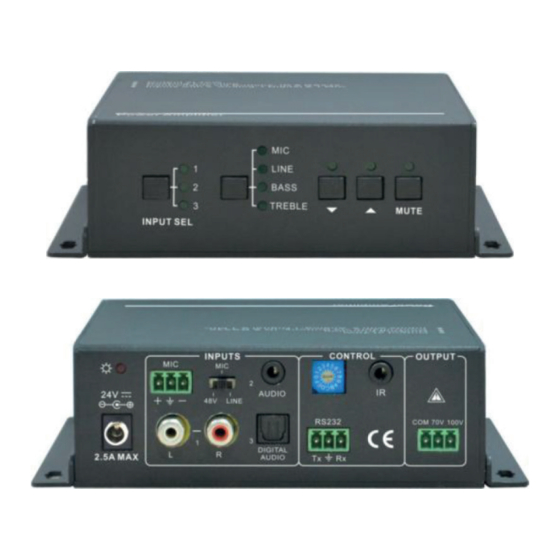
Summary of Contents for SolidView SN-607
- Page 1 User Manual SN-607 40W Power Amplifier All Rights Reserved Version: SN-6072013V1.0...
- Page 2 Please refer to the dealers for the latest details. This manual is copyright Solidview. All rights reserved. No part of this publication may be copied or reproduced without the prior written consent of Solidview.
-
Page 3: Table Of Contents
40W Power Amplifier Table of Contents 1. Introduction ......................... 1 1.1 Introduction to SN-607 ..................1 1.2 Features ......................1 1.3 Package Contents ..................... 1 2. Introduction of Product Appearance ................2 2.1 Introduction of Front Panel ................2 2.2 Introduction of Rear Panel ................. 3 3. -
Page 4: Introduction
1. Introduction 1.1 Introduction to SN-607 SN-607 is a 40 Watt power amplifier (Class-D) with output alternatively at 70V or 100V. It has 2 stereo inputs (1x3.5mm jack for line in, 2xRCA for L&R), 1 digital input & 1 balanced MIC. It is integrated with powerful functions, including ducking function, EQ control, MIC mixer etc, and MIC input supports 3 levels with condenser MIC, dynamic MIC &... -
Page 5: Introduction Of Product Appearance
40W Power Amplifier 2. Introduction of Product Appearance 2.1 Introduction of Front Panel Figure 1 Front Panel Name Function To select the input audio source, after choosing the audio source, the corresponding LED indicator will be on. No.1 is for Audio Input ①... -
Page 6: Introduction Of Rear Panel
3-pole captive screw connector for serial control, it can be ⑨ RS232 connected with PC (Use a 3-pole captive to 9 pin female D connector and serial control software) to control SN-607. To connect with audio output devices, such as speakers (To ⑩ Audio Output select 70V or 100V depends on the input voltage of the speakers). -
Page 7: System Connection
3.3 Audio Signal Connection 3.3.1 Audio Output SN-607 supports mono audio output, and the output voltage is 70V or alterative 100V. With its dual-purpose design, it can be applied in different areas. The end COM is for grounding. The amplifier to be connected is mono audio output with a rated power at 40Watt, so SN-607 can be connected with several speakers in parallel connection way (Total power mustn’t be more than 40Watt). -
Page 8: Audio Inputs
Figure 4 Audio Output Connection 3.3.2 Audio Inputs SN-607 provides with 2 stereo audio inputs, one microphone input and one digital fiber audio input. The following figure shows the audio input ports. Dial Switch, to select the MIC input mode,... -
Page 9: System Applications
Digital Audio Input • SN-607 provides with a fiber optical port to connect with digital audio source device. With the SPF optical fiber, the audio signal can be transmitted faster, more stable, reliable, and can be transmitted over a long distance without distortion. -
Page 10: Volume/Eq Controlling
“ ”. 4.2 Operations of IR Remote SN-607 provides with an IR eye, with the IR Receiver and the IR remote, user can control SN-607 remotely. Notice: The IR Receiver and the IR remote are all offered for charge. -
Page 11: Operations Of Control Software
Copy the RS232 control software to one computer, and then connect the RS232 port • of this computer and SN-607. Double-click the EXE program to execute the software. • Here we take the software CommWatch.exe as example. The icon is showed as below: Figure 11 Control Software Uninstallation Delete all the control software files in corresponding file path. -
Page 12: Running Environment
4.3.3 Running Environment While the control software is installed, we can activate the software through the RS232 port and set the parameters, to make it able to send RS232 commands to control SN-607. 4.3.4 Function Settings With the control software, we can easily switch the input channel, mute the output, check the working status, and adjust the volume etc. -
Page 13: Rs232 Communication Commands
40W Power Amplifier 4.3.5 RS232 Communication Commands Communication Protocol: RS232 Communication Protocol Baud rate: 9600 Data bit: 8 Stop bit: 1 Parity bit: none Command Function Description Feedback Code 1A1. Switching the audio to input 1 A: 1 -> 1 2A1. - Page 14 3) Preset the MIC volume to “21” degree, the command is: 521% 4) Checking the working status of SN-607, the command is: 600% 5) If the ID code is 0, sending command 601% is able to turn up the MIC volume.
-
Page 15: Specifications
Front Panel RS232 Control captive screw buttons Control connector ID Code 16 ID codes for control. Control IR remote & TCP/IP controlled by (Solidview's programmable Optional interface) General Temperature -20 ~ +70 Humidity 10% ~ 90% DC 24V power Power... -
Page 16: Panel Drawing
5) If the SN-607 amplifier cannot be controlled by the keys on the front panel, RS232 port or the IR remote, the unit may has already been broken. Please send it to the... -
Page 17: Safety Operation Guide
40W Power Amplifier 8. Safety Operation Guide In order to guarantee the reliable operation of the equipments and safety of the staff, please abide by the following proceeding in installation, using and maintenance: 1) The system must be earthed properly. Please do not use two blades plugs and ensure the alternating power supply ranged from 100v to 240v and from 50Hz to 60Hz. -
Page 18: After-Sales Service
40W Power Amplifier 9. After-sales Service 1) If there appear some problems when running SN-607, please check and deal with the problems reference to this user manual. Any transport costs are borne by the users during the warranty. 2) You can email to our after-sales department or make a call, please tell us the following information about your cases.


Need help?
Do you have a question about the SN-607 and is the answer not in the manual?
Questions and answers